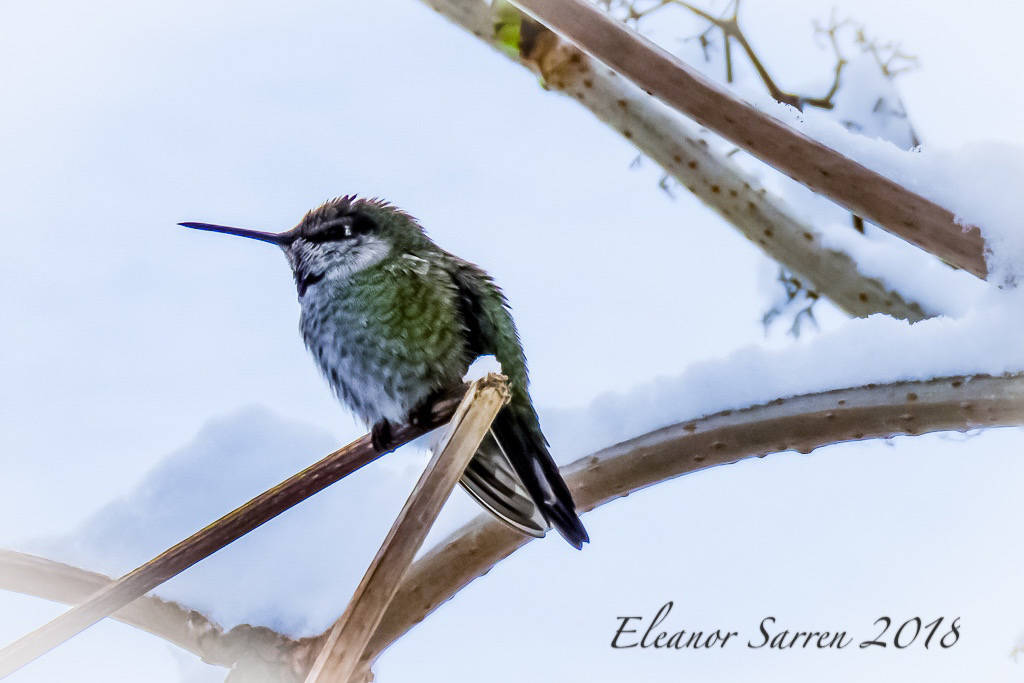One never knows in the wee hours before a Christmas Bird Count what will occur that day. The birds, the weather, the ice, the tides, the daylight and maybe even the alignment of our stars will all play a role. Those of us who love to go birding, however, are allowed to have a whole day to do nothing else but — go birding: find them, identify them and count them. I would add — enjoy them. It’s always a very special day for me, no matter what may occur, and besides the fun, our results add to the data from nearly 50 previous Christmas Bird Counts here in Homer. We have a record of what birds were here and in what numbers, and also very important, what birds were not here each year.
This year we had a heavy snowfall the night before, but Homer’s birders found 71 species, a record number for any previous Count here. The huge snowfall meant slogging though deep snow in most places, but apparently the snow encouraged the birds to be out and about looking for some chow. There were no new species found this year, but some rarer species found were Mountain Bluebird, White-throated Sparrow, Short-eared Owl, Red-faced Cormorant, Double-crested Cormorant, and four Anna’s Hummingbirds. For Count Week (three days before and three days after count day), two additional species were found: Rusty Blackbird and Lesser Scaup.
The numbers of individual birds are also important. Our overall count of individual birds, 5,540, was down this year due to low Rock Sandpiper and Mallard counts.
Fewer Rock Sandpipers were seen this year — 612 compared to twice that many last year. This number was due to the tide and light. When it is high tide, Rock Sandpipers are often roosting on the east side of the Small Boat Harbor. But this year it was still dark at high tide. When Mud Bay is clear of ice, they are usually feeding an hour or so after high tide, with some groups going farther east along the bay. But this year there was too much ice.
Due to ice, only a few mallards were found (15) compared to last year’s 2,251. A few years we’ve found no mallards — which made some birders threaten to take a flashlight and go searching down amongst the blocks of ice to find at least one mallard. But if the ice is blocking their food, they have to go elsewhere, so even the flashlight hunt after dark would not have been successful. Seems to me we should always have at least one mallard.
One common bird was unexpectedly AWOL this year. Where were the Steller’s jays? Not even one was seen on the Count Day, nor the whole Count Week. Two notices were sent out to all birders to ask folks to look for them and report any seen during that week. Even with that prompting, no one saw any. Where did they go?
We found a record number of American Robins (385), some of which are still with us, I’m happy to say. Folks always ask about Bald Eagles and Northwestern Crow numbers. Both were similar to their numbers in previous years.
The Christmas Bird Count began, historically, with hunters going out and shooting as many birds as they could in one day until 120 years ago when they realized counting them would be a much better idea. Now in all 50 states, Canada, and in Central and South America, each area chooses a circle with a 15-mile radius and teams count the birds found inside the same circle each year.
Years of data collected provide an important snapshot of the changing bird populations for winter birds in each area and region. As Dave Erikson mentioned previously, the Count provides an “invaluable profile of bird population numbers, bird movements, and associated trends.”
For a complete report of species and numbers we found, check the Kachemak Bay Birders’ website, www.kachemakbaybirders.org.
A big thanks to all the volunteers who participated, to the Alaska Maritime National Wildlife Refuge, our cosponsor, and to Dave Erikson for coordinating our Christmas Bird Count.
It was indeed “a very great day to bird.” That’s our motto.
This article is brought to you by the Kachemak Bay Birders for its monthly column, “The Year of the Bird.” For more information about Kachemak Bay Birders birding trips, meetings, and other activities and events, go to kachemakbaybirders.org.
Check out also the Bird of the Month, Citizen Science opportunities, Local Bird Information and much more. It’s a great day to bird.



